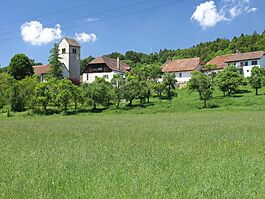Diesse facts for kids
Quick facts for kids
Diesse
|
||
|---|---|---|

View from the Chasseral toward Diesse village and Nods
|
||
|
||
| Country | Switzerland | |
| Canton | Bern | |
| District | Jura bernois | |
| Area | ||
| • Total | 9.48 km2 (3.66 sq mi) | |
| Elevation | 838 m (2,749 ft) | |
| Population
(Dec 2011)
|
||
| • Total | 436 | |
| • Density | 45.99/km2 (119.12/sq mi) | |
| Postal code |
2517
|
|
| Surrounded by | Prêles, Lamboing, Nods | |
Diesse (French pronunciation: [djɛs]) was a small town, or municipality, in Switzerland. It was located in the French-speaking part of the Canton of Bern, in an area called Jura Bernois.
It used to be its own town, but on January 1, 2014, Diesse joined with two other towns, Lamboing and Prêles. They all became part of a new, larger municipality called Plateau de Diesse.
Contents
History of Diesse
Diesse was first mentioned in old records in 1178. For a long time, it was also known by its German name, Tess, but this name is not used anymore.
The local church in Diesse was first mentioned in 1185. Around 1530, the Protestant Reformation began to spread. By 1554, the church in Diesse had become Protestant.
Until 1798, Diesse was an important center for the Tessenberg district. After the French invaded Switzerland in 1798, Diesse became part of France. It stayed under French rule until the Congress of Vienna returned it to the Canton of Bern.
A village school was built in Diesse between 1850 and 1856. The number of people living in Diesse slowly went down until the 1980s. Then, people who worked in nearby towns started moving to Diesse, and the population grew again.
Geography and Landscape
Diesse is located on a high flat area called the Plateau de Diesse. Before it merged, Diesse covered an area of about 9.5 square kilometers (3.7 square miles).
A large part of the land, almost half, is used for farming. This includes fields for crops, pastures for animals, and areas for growing fruit trees. Another big part of the land, also almost half, is covered by forests. A smaller part of the land has buildings and roads.
The area where Diesse is located became part of the new Jura Bernois administrative district on January 1, 2010.
Coat of Arms
The official symbol, or coat of arms, of Diesse is a red shield with five green Linden leaves. These leaves are arranged in a cross shape on a silver background.
Population and People
In 2011, Diesse had a population of 436 people. Over the past ten years, the number of people living in Diesse changed a little bit.
Most people in Diesse speak French as their main language. In 2000, about 88% of the people spoke French. The second most common language was German, spoken by about 9.5% of the people. A small number of people also spoke Spanish.
In 2008, about 48.6% of the population were men and 51.4% were women. About 32.5% of the people living in Diesse in 2000 were also born there.
In 2011, children and teenagers (up to 19 years old) made up 22% of the population. Adults (20 to 64 years old) made up 63.8%, and seniors (over 64 years old) made up 14.2%.
The chart below shows how the population of Diesse has changed over time:

Important Sights
The entire village of Diesse is considered an important heritage site in Switzerland. This means it has special historical or cultural value.
Economy and Jobs
In 2008, about 117 people worked in Diesse. Many people worked in farming, which is called the primary sector. Others worked in manufacturing or construction, which is the secondary sector. The largest number of jobs were in the tertiary sector, which includes services like sales, hotels, and education.
Many people who lived in Diesse traveled to other towns for work. In 2000, about 143 people commuted out of Diesse for their jobs. About 64 people both lived and worked in Diesse. Most people used a private car to get to work.
Religion in Diesse
According to the 2000 census, most people in Diesse belonged to the Swiss Reformed Church, which is a Protestant church. About 65.9% of the population were Swiss Reformed. About 13.8% were Roman Catholic. Some people belonged to other Christian churches, and about 10.7% did not belong to any church.
Education System
In Diesse, many adults have completed more than the basic schooling. About 56.6% have finished upper secondary education, and 17.5% have gone on to university or a specialized college.
The school system in the Canton of Bern starts with one year of optional Kindergarten. After that, students go to six years of Primary school. Then, they attend three years of lower Secondary school, where they are grouped by their abilities. After lower Secondary, students can choose to continue their education or start an apprenticeship.
During the 2011-2012 school year, 86 students attended classes in Diesse. There were two kindergarten classes with 32 students and three primary classes with 54 students. Some of these students were not Swiss citizens, or they spoke a different language at home than the one used in class.
In 2000, 111 students attended school in Diesse. However, many students from Diesse also went to schools in other towns.
Images for kids
See also
 In Spanish: Diesse para niños
In Spanish: Diesse para niños






